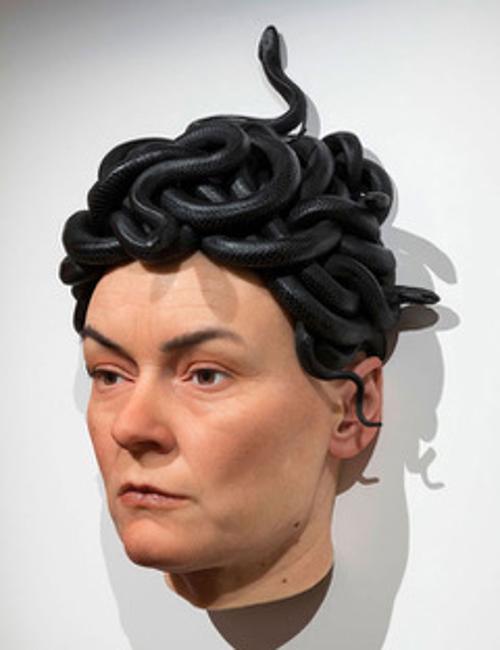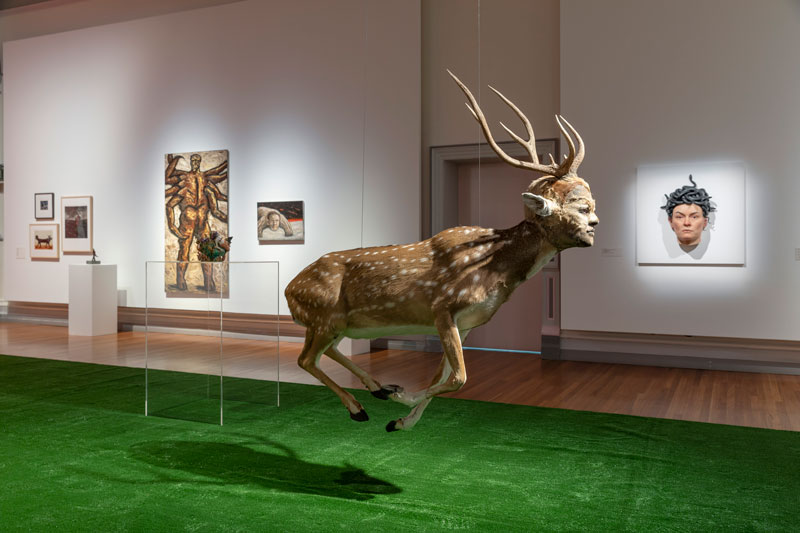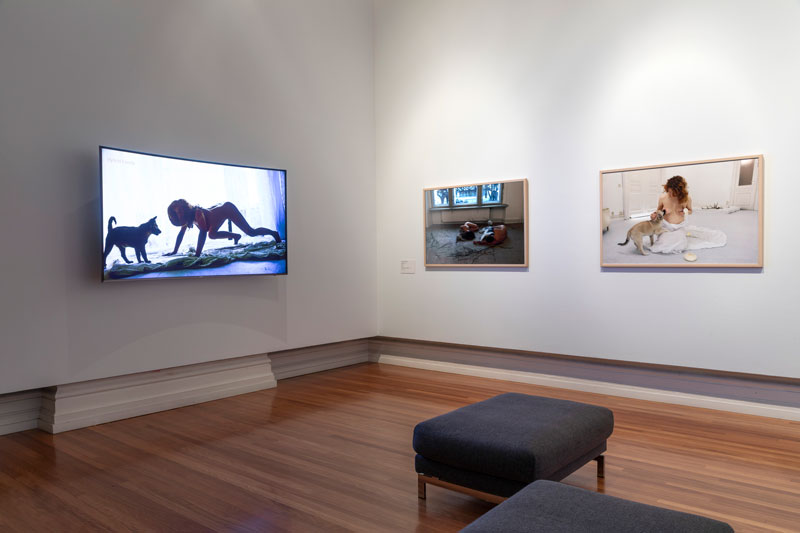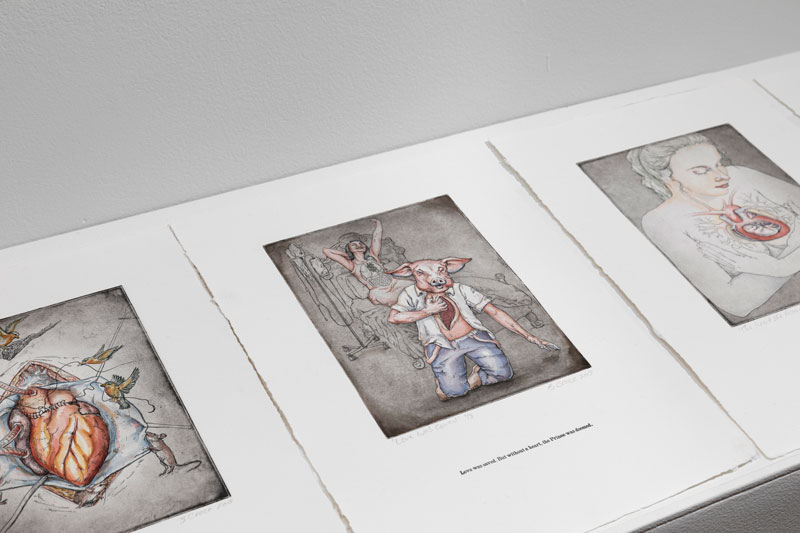
In My Monster: The Human–Animal Hybrid, currently showing at the RMIT Gallery in Melbourne, curator Dr Evelyn Tsitas brings together 35 Australian and international artists to explore the blurring of human and animal, a captivating in-between realm often culturally construed as monstrous. Indeed, anthropologist Victor Turner argues that industrialised humans seek in the contemporary arts the liminal space between the human and the animal that we once explored through myth and ritual.[1] We are compelled to return to the margins.
The My Monster exhibition was timed to coincide with the 200th anniversary of Mary Shelley’s gothic novel Frankenstein, or, The Modern Prometheus (1818), a tale of a creature fashioned not only from human corpses but also from animals sourced from “the dissecting room and the slaughter-house.”[2] The scientist Victor Frankenstein imagines that the “new species would bless me as its creator,” but as Anne K. Mellor points out, he never stops to think whether he might have responsibilities towards that new being.[3] While the narrator has a profound failure of empathy, the reader (and in the case of the many film adaptations, the viewer) is invited to identify with the creature’s plight.

This empathy for the human-animal hybrid continues to resonate and have ethical potency in our own era, which only last year saw the first Chimera embryo—a controversial combination of human cells injected into a pig embryo, in research aimed ultimately at creating “lab-grown organs.”[4] Included in this exhibition, Maja Smrekar in her performance piece K-9_topology: Hybrid Family (2016) splices her cells with those of her dog, reframing the Chimera in a work exploring inter-species family bonds, in the process questioning the purely human aims of this field of science.
That scientist call these hybrids Chimeras is telling. The Chimera is a fire-breathing creature from Greek myth who, according to Homer’s Iliad c. 850 BCE, was “a thing of immortal make, not human, lion-fronted and snake behind, a goat in the middle.”[5] It is not entirely reassuring—nor probably the intended resonance for contemporary scientists using the term—that Apollodorus later describes the Chimera as devastating the land with “the power of three beasts.”[6]
The destructive potential of the Chimera is conveyed in many of the horror film trailers compiled for My Monster, including, appropriately, Maurice Haeems’ 2018 Chimera. But the Chimeras created by human rather than “immortal” hands frequently seek escape rather than violence. Jane Alexander’s photographic work Post Conversion Syndrome (in the wild) (2004) depicts the Chimera on the run from humanity, fleetingly glimpsed on the very edge of the frame. It seems as if the creature momentarily locks eyes with the viewer, but the aesthetics of the piece, with its blurry focus and asymmetrical composition, suggest that this Chimera is desperately trying to avoid both physical and photographic capture.

Shelley’s Frankenstein is fraught with the anxieties of the bourgeoning scientific age, while its often-neglected subtitle—The Modern Prometheus—also connects science back to Greek myth. Prometheus creates humanity out of clay, tricks the gods into a sacrificial arrangement more favourable to humans, and steals fire from Zeus, the father of Olympian gods, in what E. F. Beall calls “an attack on Zeus’s very divinity.”[7]Victor Frankenstein, the progenitor of many mad scientist figures to come, is thereby aligned by Shelley with this mythic trickster figure who upsets the divine order.
Several works in My Monster address the human–animal across both these mythic and scientific resonances, while the exhibition logic invites such connections between different works. The intaglio print series The Pig Prince, A Xenophobic Tale (2018) presents pages from an imagined children’s unbound story book by medical illustrator Beth Croce. It is a love story in which a pig prince literally gives his heart in the ultimate sacrifice; xenotransplantation in the form of a delicately rendered fairy tale. Tsitas writes, “as we absorb the animal into us, via pig insulin, or pig valves and bovine cardiac tissue routinely used in heart surgery, where do we draw the line at ‘us’ and ‘them’?”[8]
The hybrid creatures on display across the exhibition each speak to this liminal and existential uncertainty in different ways, while others seek to destabilise the medical hierarchy in which humans are the beneficiaries of non-human animal bodies. While Croce’s piece focuses overtly on transplantation from the non-human animal to the human, Smrekar’s Hybrid Family includes giving her breastmilk to her dogs, captured in digital prints that emphasise the textures of hair, fur, skin and milk. Smrekar’s work calls to mind the Roman myth of Romulus and Remus, who were suckled by a wolf, but in making her dogs the recipients of human body products, Smrekar inverts both medical and mythological discourses and invites the viewer to consider issues of reciprocity.

.jpg)
Sitting across from Hybrid Family, Julia deVille’s Peter (2012) presents a small rabbit perched in an antique sterling silver goblet. The piece is used to comment on the bizarre true story of Mary Toft, who in 1726 convinced the world that she had given birth to rabbits, highlighting that scientific discourse of the era was not firmly separated from superstition and folk tales. Mary recanted on her claim only when asked to submit to an internal examination. The somewhat alarming set of obstetric forceps displayed next to deVille’s Peter, further invite an alignment between the treatment of women and non-human animals.
The title immediately recalls Beatrix Potter’s Peter Rabbit (1901), to also support identification with the creature and its shiny little visible eye. Indeed, deVille’s ethical taxidermy—using only animals who have died of natural causes—has been described as “reminiscent of a gothic fairytale.”[9] Peter was originally part of the Animal Kingdom exhibition at the Johnson Collection last year, in which baby animals were presented in crockery and silverware laid out on a dining table to make the visitor contemplate the ethics of their eating practices, and empathise with the non-human other.[10] With permission of the artist, the work has been recontextualised in the My Monster exhibition, its juxtaposition with ominous medical equipment heightening the rabbit’s fragility, and fostering a “creaturely poetics” to use theorist Anat Pick’s terminology, in which we are encouraged to acknowledge the “vulnerability of beings—whether human or not.”[11]
The deceased Peter uncannily stares back at us, and the power of the returned gaze echoes throughout the exhibition. Another rabbit, called Dutch (2009), appears in Rona Green’s hand-coloured linocuts, adorned with tattoos and bearing down on us with an unsettling ferocity. This is far from the cute, fluffy bunny trope of children’s story books, and Green manages to capture a sense of accusation and forceful sentience in sparse lines. While Dutch has the hint of human shoulders, suggesting a rabbit/human hybrid, this is more overt in her other pieces in the exhibit, such as Pascal (2017), a goat/human in suit and tie, and The Surgeon (2010), a cat/human based on the artist’s own companion animal, here shown squaring off at the viewer with a menacing attitude.
Somewhat unexpectedly, a work that refuses to return the gaze is Sam Jinks’ oversized head of Medusa (2016). Visitors were reminded not to touch this piece. The hyper-real, haptic textures of the work rendered in silicone, pigment and resin, made it hard to resist. Here, the Medusa is shown looking off into the distance as snakes writhe on the top of her head, but significantly, no matter where you stand in the gallery, she does not meet the visitor’s gaze. In the most well-known version of the Medusa myth (from Apollodorus’ Library and Pausanias’ Description of Greece, both late versions of the story), the Medusa’s gaze can turn a person into stone.[12] Jinks’ Medusa refuses this deadly exchange of looks but frequently brings its viewers to a standstill in the gallery nonetheless. Hélène Cixous, in her famous 1976 feminist article, “The Laugh of the Medusa,” proclaims, “you only have to look at the Medusa straight on to see her. And she’s not deadly.”[13]Jinks’ Medusa may not be laughing, but having been modelled on the artist’s wife,[14] the work gives the mythic figure a specificity that encourages the viewer to see her personhood.
.jpg)
Classicist Sarah Iles Johnston argues that even when we focus on just one version of a mythic figure such as Medusa, it is “never actually alone,” because it is inflected by a vast interconnecting array of other variations of the tale and other Greek myths.[15] In our contemporary use of myth, this complex background extends beyond the original context to include millennia of retellings in different media. Different eras of stories and images jostle together in our individual and collective memories. My Monster approaches this complexity by arranging work in five sections that relate to chapters from curator Tsitas’ doctoral thesis, each with Greek names: xenos (foreigner/stranger), mythos (stories/tales/narrative), tokos (childbirth/reproduction), eros (erotic love), and kosmos (the world/universe). Despite the separate section for mythos, mythological traditions traverse the different rooms. Medusa, for example, is placed within the xenos section.
.jpg)
My Monster also explores the myth of the human-animal hybrid by mixing new works with older pieces by Sidney Nolan, Peter Booth and Norman Lindsay. This creates juxtapositions at once problematic and productive. Nolan’s Leda and the Swan (1960) resonates uncomfortably with issues of consent in variants of the myth. Its inclusion speaks to the longevity of mythic and artistic fascination with the non-human, but also to shifts in the politics of art practice in addressing the subjectivity of both women and non-human animals.[16] Several contemporary artists address the anthropomorphism that threatens to destabilise an equal meeting of species by positing a non-human animal sensory perspective. The Sensible World (2018) by (((20hz))) exposes the expansive electromagnetic spectrum experienced by other species and normally inaccessible to humans. Moira Finucane and Shinjuku Thief’s new installation work The Rapture/Fur Can't Fly (2018) is an affective and immersive experience that speaks to a human yearning for flight but becomes a visceral sensory experience of potential otherness.
The visitor sits alone in a chair in a dark room that is filled with feathers, and with closed eyes, a combination of vibration, movement, light and sound ensue to evoke the idea of flight. These works speak not only to a human longing for the non-human animal, but also to the difficulties of bridging the species divide. We are tantalisingly close to the non-human animal in genetic terms, yet as Barbara Creed notes, our sensory capabilities are so very different as to pose a continual challenge to artists seeking to inhabit and aesthetically express the human-animal boundary.[17]
On the opening night to the exhibition, crowds stretched down the street and around the corner from the gallery. We continue to be drawn to the human-animal hybrid, despite and because of its seemingly monstrous nature. It is telling in this respect that the name Frankenstein is often mistakenly attributed to the creature. It belongs, rather, to the scientist, the new Prometheus. Who is the true monster of Shelley’s novel? In turn, this exhibition ultimately asks, who is “my” monster?
Footnotes
- ^ Victor Turner, “Variations on a theme of liminality,” in S.F. Moore and B.G. Meyerhoff (eds), Secular Ritual, Amsterdam: Van Gorcum, 1997, pp. 37, 41–3.
- ^ Mary Wollstonecraft Shelley, The Novels and Selected Works of Mary Shelley, Volume 1: Frankenstein, London: W. Pickering, 1996, p. 38.
- ^ Mary Wollstonecraft Shelley, The Novels and Selected Works of Mary Shelley, Volume 1: Frankenstein, London: W. Pickering, 1996, p. 37; Anne K. Mellor, “Making a ‘monster’: An introduction to Frankenstein,” in Esther Schor (ed.), The Cambridge Companion to Mary Shelley, New York: Cambridge University Press, 2012, p. 11.
- ^ Erin Blakemore, “Human-Pig Hybrid Created in the Lab,”National Geographic, 26 January 2017: https://news.nationalgeographic.com/2017/01/human-pig-hybrid-embryo-chimera-organs-health-science/
- ^ Homer, Iliad, (trans. Richard Lattimore), Chicago & London: University of Chicago Press, 1951, pp. 6., 179–82.
- ^ Apollodorus, The Library, (trans. James George Frazer), Cambridge, MA: Harvard University Press & London: William Heinemann, 1921, 2.3.1: http://www.perseus.tufts.edu/hopper/textdoc=Apollod.%202.3.1&lang=original
- ^ E. F. Beall, “Hesiod’s Prometheus and Development in Myth,” Journal of the History of Ideas, vol. 52, no. 3, 1991, p. 359.
- ^ Evelyn Tsitas, “Media Background,” 2018, supplied. Katheleen Calderwood, “Paddock to patient: How Australian beef cattle are being used to create heart valves and save lives,” ABC News, 3 June 2017: http://www.abc.net.au/news/2017-06-03/australian-cattle-are-being-used-to-create-heart-valves/8579012
- ^ undefined
- ^ Lindy Percival, Ibid.
- ^ Anat Pick, Creaturely Poetics: Animal Vulnerability in Literature and Film, New York: Columbia University Press, 2011, pp. 3, 5.
- ^ Sarah Bernice Wallace, “The Changing Faces of Medusa,” Reinvention: A Journal of Undergraduate Research, British Conference of Undergraduate Research 2011 Special Issue, 2011:https://warwick.ac.uk/fac/cross_fac/iatl/reinvention/issues/bcur2011specialissue/wallace/ .
- ^ Hélène Cixous, “The Laugh of the Medusa,” (trans. Paula Cohen and Keith Cohen), Signs, vol. 1, no. 4, 1976, p. 885.
- ^ Huang Lijie, “Modelling a monster after his wife,” The Straits Times, 10 January 2017: https://www.straitstimes.com/lifestyle/arts/modelling-a-monster-after-his-wife. This fact is not revealed at My Monster, but nonetheless gives resonance to the possessive “my” of the exhibition.
- ^ Sarah Iles Johnston, “The Greek Myth Story World,” Arethusa, vol. 48, no. 3, 2015, p. 297.
- ^ See for example Helen Sword “Leda and the Modernists,” PMLA, vol. 107, no. 2, 1992, p. 316.
- ^ Barbara Creed, “Entangled looking: The crisis of the animal,” Artlink, 38:1, 2018, pp. 15–17.
